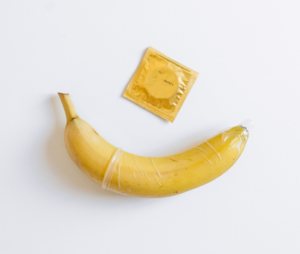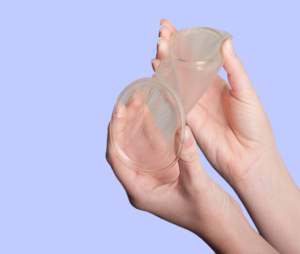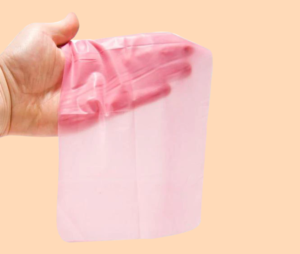It’s Valentine’s Day National Condom Day!
It’s no coincidence that Valentine’s Day and National Condom Day fall on the same day… but in terms of which one we’re celebrating, well, that’s a no brainer.
Here at Play Safe, we’ll take any excuse to celebrate condoms, but today, on National Condom Day, we’re going in *deep*.
First things first
When it comes to safe sex, nothing beats a condom.
Did you know that condoms are the only form of contraception that protects against both sexually transmitted infections (STIs) and unplanned pregnancies?
These days, condoms are easy to find, easy to use and there’s a condom for everyone. But this wasn’t always the case…
A brief (and weird) history of condoms
Over the years, there have been countless attempts to develop what we know today as a condom. Here are some of the highlights.
This should go without saying, but do not try any of these at home.
- Around 3000 BC, King Minos of Crete is said to have used a condom made from the bladder of a goat
- The Ancient Egyptians used linen sheaths during sex to prevent tropical diseases like Bilharzia
- In early Japanese civilisation, men used to put caps made of tortoise shell over the head of their penis
- During the 17th century, condoms were made by butchers out of sheep or goat intestines
- The first rubber condom was created in the 1800s – they weren’t as gross as animal intestines, but did have to be fitted to size…
- Modern latex condoms were invented in 1920 – thin, comfortable and more natural feeling than the previous rubber versions that were really thick
- In 1957 the first pre-lubricated external condom was launched (yay!)
- In March 2013, Bill Gates launched a global competition to develop the next generation of condoms (who knew?!)
These days, it’s estimated that over 22 billion condoms are produced around the world each year and we’re pleased to report that they’re better than ever.
Types of condoms
Did you know that there are more than one kind of condom? Ahuh, no matter what kind of sex you’re having, there’s a condom for you!
External condoms
External condoms are what most people think about when they hear the word condom. They are made of a thin piece of latex (rubber) or polyurethane (soft plastic) and can be put onto an erect (hard) penis before oral, vaginal or oral sex. There’s a variety of sizes, colours, flavours and textures so be sure to try a few different options until you find a one that works for you. Allergic to latex? No worries! Latex-free condoms are readily available across Australia.
If you’re under the age of 25, you can get FREE condoms via the Freedom Condom project. Otherwise, you can buy external condoms from any chemist, supermarket, service station or even online.
Want to know more? Find out how to use an external condom, how to ask a partner to use a condom and even how to turn an external condom into a dental dam.

Internal condoms
Internal condoms are made from polyurethane and can be inserted into the vagina or anus before sex. They are about 15cm long and have two flexible rings, one at each end, to keep them in place. In the past, they were sometimes referred to as female condoms.
Internal condoms can be hard to find so if you want to give them a go, your best bet is to buy some online.
Check out our guide to using internal condoms here.

Dental dams
Dental dams are thin, stretchy latex or silicone rectangles that can be used during oral sex to prevent STIs. In Australia, dams can be expensive and hard to find, but you can always turn an external condom into a dam, with a little DIY.

Condoms 101
It’s all well and good to use condoms, but it’s important that you’re using them consistency and correctly. Here are some of our do’s and don’t when it comes to condoms.
DO’s
- Check the expiry date before you use a condom (if it’s out of date, there’s a higher risk of it breaking).
- Use water-based lube to reduce the chance of the condom breaking and to make sex more comfortable for everyone.
- Try different brands and styles of condoms to see what feels and works best for you. Don’t think you like the feeling of condoms? Try a different brand or size (trust us, it can make all the difference!).
- Put on a new condom each time you switch between oral, vaginal and anal sex. Also be sure to change condoms between partners if there’s more than two of you.
- Use condoms on sex toys if you’re sharing them.
- Talk to your partner/s about using condoms. It’s not always easy but it is important. Read our top tips for tackling the condom chat.
- If you’re having a long sex session, it’s a good idea to change condoms after 30 minutes. Extended friction can weaken the condom, making it more likely to break.
DON’Ts
- Don’t use oil-based lubricants like coconut oil, Vaseline, body locations or massage oils with latex condoms. They damage the latex and lead are more likely to break.
- Don’t leave condoms exposed to extreme temperatures such as in your car or wallet for extended periods of time – they perish!
- Don’t open the condom packet with your teeth or scissors as you might tear it.
- Don’t use more than one condom at a time. More condoms doesn’t mean more protection.
What should I do if the condom breaks?
If you’ve had a condom break during sex, don’t panic. Instead follow these simple steps:
-
- Stop what you’re doing
- Withdraw
- Remove the broken condom and dispose of it
- Put on a new condom
- Carry on with what you were doing (after making sure your partner/s wants to)
- Consider whether you need emergency contraception or PEP
- Get an STI test after 7-14 days, unless you get symptoms earlier. Any sooner and any potential infections might not be picked up by the test.
If your STI test comes back positive your doctor/nurse will let you know what treatment you need and what to do next. Remember that treatment for many STIs is quick and easy.
Condoms offer excellent protection but there’s still a small chance of passing on an STIs to your partner/s. That’s why getting regular STI tests every 6-12 months is so important, even if you use condoms and/or other contraception.
Could I have an STI?
If you’ve ever had vaginal, oral, or anal sex then there is a chance that you could have an STI.
Did you know that many STIs have no symptoms and if left untreated can cause long-term health concerns? That’s why it’s so important to get tested every 6-12 months, even if you’re using condoms and/or other contraception.
STI testing is confidential, often free and as easy as a quick blood test and urine sample.
So what are you waiting for? Find you nearest STI testing location today.
If you want to know more about condoms or STIs, call NSW Sexual Health Infolink on 1800 451 624 to talk with a qualified sexual health nurse. It’s free, confidential and totally anonymous. If you’d prefer to ask a question online, click here.
Related posts
Can I get an STI from oral sex?
Although it’s more common for sexually transmitted infections (STIs) to be passed on during vaginal and anal sex, it is possible during oral sex too. Yep! You heard that right.
Read more
5 condom myths
Did you know that condoms are the only form of contraception that protects against both STIs and pregnancy? But for some reason, some people choose not to use them when having sex. Let’s breakdown some of the common excuses that we hear when it comes to not using condoms. Condoms […]
Read more




